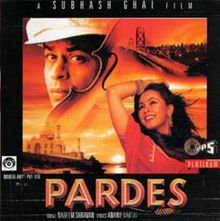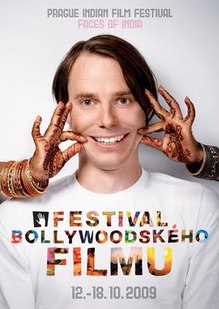Is It All About the Hips?: Sangita Shresthova on Bollywood Dance (Part One)
/Sangita Shreshtova, a 2003 Alumni of the MIT Comparative Media Studies Program, recently published an informative and engaging new book, Is It All About the Hips?: Around the World With Bollywood Dance, which explores some important questions at the intersections of transnational media, participatory culture, and film performance. She writes with the experienced eye of someone who is herself a gifted dancer and choreographer and with the theoretical sophistication of someone who has gone through several top academic programs.
This engaging ethnography explores the ways Bollywood dance is moving off the screen and into the everyday lives of fans all over the planet, through attentive close studies of what performance means in a range of different local contexts (from London and Los Angeles to Kathmandu). Shreshthova knows from her own work as an organizer of the Prague Bollywood Film Festival that these films, their music, and their dance cultures, are traveling not only to places where there is a strong South Asian diasporic community but also into places which have had limited history of contact with India before. This is part of the fascination of our current moment where popular culture is being circulated across traditional borders in ways which produce unexpected consequences.
I have been lucky enough to have worked with Shreshtova, first as my graduate student at MIT and now as the research director on the CivicPaths project here at USC, so it is a source of great pride and pleasure to be able to share with you this interview. Here, she shares both her own journey to write this book and some core insights about the transnational contexts within which contemporary popular and participatory culture operates.
In your acknowledgements, you describe Bollywood dance as "a messy, yet appealing, reflection on my own scattered cultural identity." What aspects of your autobiography did you draw upon in shaping this book? Is there something about Bollywood entertainment which speaks especially to the diasporic experience?
While my book is based in ethnographic and academic research, there are certainly some autobiographical elements that informed its final shape. For one, my initial encounters with Hindi films are interwoven with my own cultural struggles to define my Czech-Nepali mixed race identity growing up in Kathmandu. It was during this time that I was first drawn to the hybrid content of Hindi film song-and-dance sequences. Much later, I was once again drawn to Hindi films as a homesick undergraduate student at Princeton University. At that time, I was so grateful to the Indian students who shared their Bollywood audio and video collections with me. The songs and images became an accessible way for me to feel connected to a familiar culture in ways that somehow eased the profound isolation that dominated my initial years in the United States. Watching the films also connected me with other students in similar situations.
Films like Pardes (1997) really catered to diasporic nostalgia. Image from: http://en.wikipedia.org/wiki/Pardes_(film)
When I returned to the study of Bollywood as a graduate student in Comparative Media Studies at MIT, I, of course, drew on these early experiences with Bollywood. I then combined my research with my training in dance and media.
So yes, to me, Bollywood films, in general, are very well suited to the diasporic experience. For one, they provide accessible familiar content that can be shared in the community. To me, the hybrid nature of the films themselves is also particularly well suited to the fragmented identities that emerge out of particular diasporic experiences. And, Bollywood dance specifically is an eloquent commentary on the juxtaposition of the global flow of media enabled by media technologies and the physical experience of these images on a local level. This is why I am particularly cautious about the nostalgic urge to treat Bollywood film content as representative of Indian (and at times even explicitly Hindu) culture. To me the richness of Bollywood (dance) is its portable mixing of cultural content that enables multiple (related) meanings to emerge in multiple locations.
You describe Bollywood dance as "a participatory culture based in Hindi film fandom." What forms does the participation take? How is it linked to other forms of fan practice which surround these films?
There are many practices associated with Hindi film (and more recently Bollywood) fandom, including keeping up with current trends within the industry, organizing screenings, creating art inspired by films and actors, and following references to other films and actors within a given narrative. To me, the shared memory of films is really central to Bollywood fandom. This pleasure may further be encouraged when audiences make watching Hindi films a group activity - to be shared with relatives and friends.
As one of the organizers of the Prague Bollywood Festival, I had the opportunity to witness and encounter many Bollywood fans. (image source: www.bollywood.cz)
In many ways, Bollywood dance grew out of these shared pleasures. Put simply audiences wanted to experience the films first-hand. The also wanted to share these pleasures with others through performance. In this context, thresh-hold to participation in Bollywood dance was very low and took place in the privacy of people's homes or at community gatherings. Anyone could participate. By emulating particular movements from films, dancers could summon up the shared memories of those films. They would also teach movements to each other and invite others to join in as best they could. In many ways, Bollywood dance movements became a shared language of Bollywood film fandom. To me, this is what makes Bollywood dance a participatory culture.
In some ways, current trends towards a more "professional" Bollywood dance as live performance are now changing these practices. There is, however, no indication that the Bollywood dance as fandom is about to fade any time soon.
You are describing a phenomenon throughout the South Asian diaspora where Bollywood dance classes are growing in popularity, sometimes at the expense of more classical Indian dance. What factors have contributed to this growth? What do you see as some of the consequences?
The relationship between Bollywood dance and the Indian classical dance world is quite controversial and has been for some time. For the sake of clarity, I will situate my answer within the United States and limit my observations to this context. The growing popularity of Bollywood dance and its frequent positioning as representative of Indian dance has indeed caused much concern among Indian classical dancers in the United States. While I am not sure about the actual enrollment numbers, there is a general sense that Bollywood dance is gaining in popularity at the expense of Indian classical dance and many classical dance teachers have expressed their distress at this trend. Often this distress also is tinted with a slight disdain for Bollywood dance, which classical dance teachers tend to see as a less refined, dislocated and even crass from entertainment. There is also a sense that Bollywood dance is in some ways riding on the coat tails of the hard work that many Indian dancers have done to establish and raise awareness about Indian dance outside India. The popularity of Bollywood dance is also a source of concern for those advocating the preservation of specific (conservative) elements of Indian culture in the lives of Indian-American youth who may otherwise only feel a very tenuous connection to Indian culture.
Students of Bollywood dance often feel that Bollywood dance is much more accessible, malleable, learnable, and fun than Indian classical dance. As source material, song-and-dance sequences from Hindi films are today quite readily accessed through sites like Youtube.com. Students can quickly adapt movements to suit their skill level. They may be in a position to show off their moves to their friends quite quickly as well. In contrast, music to classical Indian dances is often a closely guarded and will only be shared once a teacher deems the student is ready to make a public appearance. There are very few or no compromises made to accommodate student's skill level. They have to master set dances. It may take years before an Indian classical dance student actually has a dance to show and even longer before he/she is ready to perform in public.
Reflecting on these realities, several Bollywood and Indian classical dance teachers have been searching for new ways to address this situation. More and more often, Bollywood dance teachers and dancers make a very active effort to integrate Indian classical elements (and at times actual full classes) in their teaching. They often also actively encourage that their students study classical Indian dance. On the other hand, Indian classical dance teachers make efforts to add Bollywood (or as they prefer to call it Hindi Film dance) components into their repertoire. Drawing on the Indian classical dance Kathak, Anjani Ambegaotkar has choreographed an ode to Hindi film dance in "Made in Mumbai", and Made in Mumbai II.
Sangita Shresthova is Czech/Nepali scholar, filmmaker, dancer and media scholar, Sangita's work has been presented in academic and creative venues around the world including the Schaubuehne (Berlin), AIGA Boston/ATE Massaging Media Conference (Boston), the Other
Festival (Chennai), the EBS International Documentary Festival (Seoul), the American Dance Festival (Durham, NC), and Akademi's Frame by Frame (London, UK). She holds a Ph.D. from UCLA's Department of World Arts and Cultures and earned a MSc. degree from MIT's
Comparative Media Studies program where she focused on Hindi film dance. Sangita is also founder of Bollynatyam (www.bollynatyam.com). She currently works with Professor Henry Jenkins on questions related to participatory culture, new media, and civic engagement.



